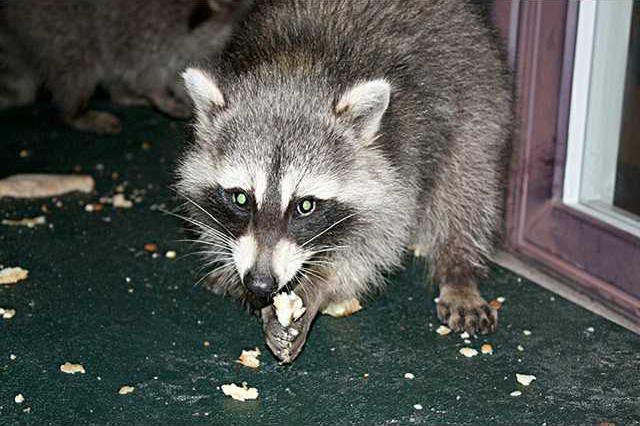Local veterinarians and the Veterinary Health Center at Kansas State University are joining forces to warn the public to be on the lookout for raccoons, especially those showing up in the daytime, as they could be infected with canine distemper and be a health threat to dogs.
“We just want to alert the public there is an increased risk,” said Great Bend vet Dr. Bill Niederee. This is a statewide concern, but with the waterways and abundant wildlife in this area, extra vigilance is recommended.
The K-State center’s exotic, wildlife and zoo animal medicine service has seen a large number of raccoons in the clinic recently that are suffering from canine distemper.
“When we see a wild animal acting sickly in the daylight, we assume it has rabies or distemper,” Niederee said. “Raccoons have always been a harborer of canine distemper.”
Distemper, like rabies, is a virus that can be fatal, Niederee said. Behind rabies, it is the second most common vaccine he administers to dogs.
An uptick in cases
“While we may see raccoons on a fairly regular basis, there seems to be a recent uptick in cases,” said James Carpenter, professor of exotic pet, wildlife and zoological medicine in the College of Veterinary Medicine. “The raccoons are often found out during the day, showing abnormal behavior such as incoordination, difficulty in walking and aimless wandering.”
“They either are just sitting back or some of them can be aggressive,” said George Sears, animal control officer for the city of Manhattan. “Or they’ll walk for a couple of feet, then they stumble, they fall down and sit right back up, giving us what’s called the ‘thousand-yard stare’ — like they’re staring out into nothing. That’s when we usually apprehend them.”
Canine distemper is a highly contagious viral disease and can spread from infected raccoons to susceptible dogs. Although not a common disease in pets, Carpenter said that the recent increase in raccoons with distemper demonstrates how the virus continues to circulate.
Because there is no way of controlling distemper in wild animal populations, Carpenter said it is important that dogs be vaccinated against this disease at 6 weeks of age and then every three to four weeks until 18-20 weeks of age. Then vaccinations should be every one to three years, depending on the recommendation of your veterinarian.
Vaccine recommended
But, where the annual rabies vaccine is required by law, distemper is not, Niederee said. He recommends this be given every year as well.
The public also is advised not to permit their dogs to roam free and come in contact with wild raccoons. But, this is unrealistic in an area where dogs live on farms and are used in hunting, making the shots that much more important, Niederee said.
In addition, Carpenter said that raccoons have the potential to carry many other diseases, including rabies, which can affect humans as well as dogs. Any abnormally acting raccoon should be reported to the local animal control office.
Starting in August, Sears said about two or three raccoons have been picked up each week in Manhattan.
“When an outbreak occurs in a raccoon population, the highest incidence is generally in late summer,” Carpenter said. “The young are leaving their mothers and have more opportunity for exposure to other wild animals that are distemper-infected.”
Because rabies can be clinically confused with canine distemper, the public should not attempt to capture or handle these animals.
“We try to deter the public from making any kind of engagement with the raccoons,” Sears said. “We encourage them to call animal control. That way we can take proper precautions, and then we can take them away from the area. It’s a safety issue.”
The Veterinary Health Center recommends owners take dogs that are unvaccinated or are not current on their canine distemper or rabies vaccinations to a veterinarian.
Other concerns
While rabies and distemper are the most common problems, other dangers lurk for pets and hunting dogs in this rural area, Niederee said.
While not a virus, leptospirosis is caused by a spirochete which is more closely related to a bacteria. A disease that causes fever and lethargy in dogs, it is carried through mouse and deer urine.
So, if a dog comes in contact with contaminated water, it can become ill, Niederee said. Shots for this are also suggested.
And, there is a relatively new rattlesnake vaccine available. If a dog is bitten, this can reduce the symptoms of the bite.
Many may not realize it, but there are a large numbers of rattlers in the region, especially around Cheyenne Bottoms Wildlife Area, Quivira National Wildlife Refuge and Lake Wilson, Niederee said.





